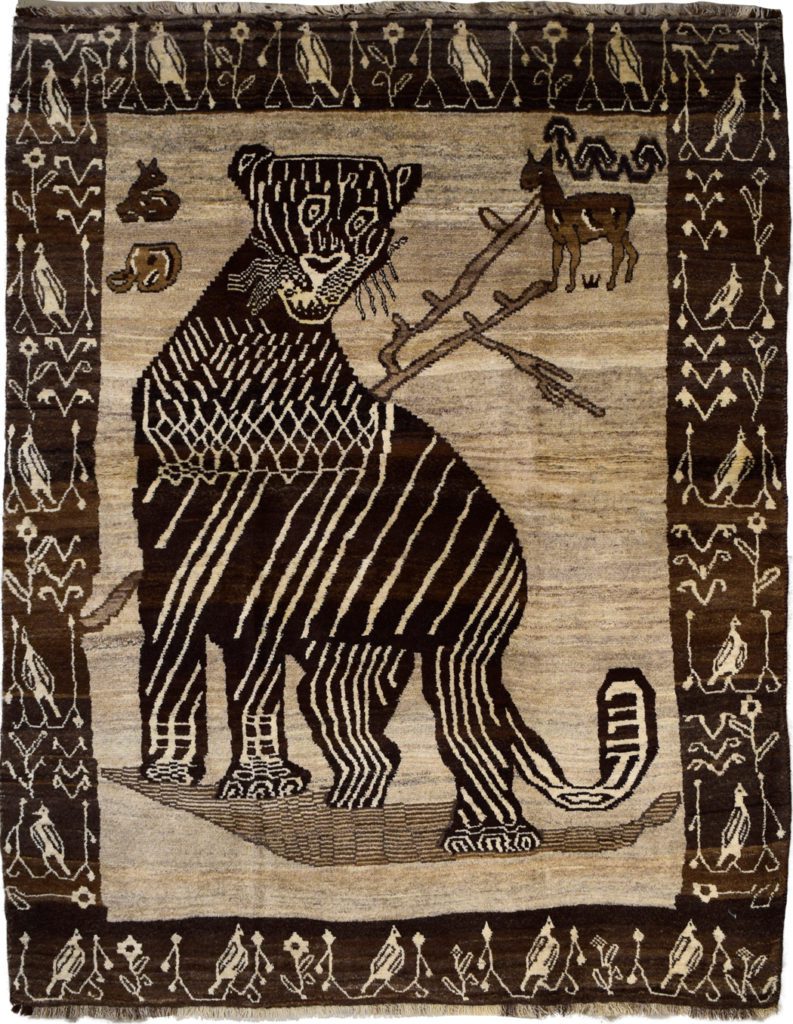Antique Spotlight – Neutral Leopardess
This week’s Antique Spotlight highlights one of our most cherished tribal Persian carpets, this Neutral Qashqai Leopard carpet. Let’s hunt through this week’s Antique Spotlight and learn more about this Leopard Carpet’s design and its traditional hand-knotted construction.
In lush varied neutral hues of cream, tan, and chocolate brown, this tribal carpet measures 6’ x 7’9” and consists of a hand-knotted pure wool pile and a wool warp and weft foundation. Its design depicts a Persian leopardess, detailed with contrasting hues of dark brown and light cream wool. Intricate tribal-style linear motifs create depth and intrigue throughout the big cat’s form and features, such as its whiskers, claws, and tail. Two fawn motifs completed in light brown and taupe wool sit among the top of the field, keeping distance from the hungry predator. A stylized border of alternating birds and branches encapsulates the Leopardess figure and surrounding field, acting as a frame for this epic scene.
Within Persian textiles, especially Persian carpets each motif carries an intended symbolism. In our example, big cats, such as leopards or tigers, represent leadership and spiritual awakening. Equally significant, birds also possess strong symbolism, signifying peace and divine protection. And ultimately, the carpet’s overall design depicts the circle of life, where one element requires the other to survive. This symbolic intention not only informs the carpet’s design but also evokes inspiration and tranquility among the beholder, as intended by the weaver. In addition to its unique and powerful imagery, this Qashqai carpet features one-of-a-kind craftsmanship that further elevates its special place among Orley Shabahang’s collection.


Entirely hand-knotted, this Leopardess carpet’s construction requires traditional Persian weaving techniques to craft its plush pile. If re-created today, a team of two weavers could spend between 6 to 7 months to complete this piece. The traditional weaving process requires weavers to source the highest quality raw materials. These materials include high-quality wool shorn from Persian fat-tailed sheep and organic vegetable dyes to create incredible hues. Renowned for its shiny and incredibly durable fibers, the wool from the Persian fat-tailed sheep is ideal for carpet weaving. Once shorn, weavers hand spin the heaps of yarn into batches. This hand-spinning step re-incorporates lanolin into the wool and forms fabulous striations within the design. Once spun, weavers utilize the bundles of all-natural shades of wool and begin hand-knotting each thread of the pile onto the foundation.
The artistry of Persian weaving is passed from generation to generation, typically carried out in a separate room reserved for weaving. Working side by side, usually mother and daughter, the weavers imprint their creativity into each carpet, making them truly one of a kind. An artisan’s touch elevates a Persian rug from other modern or machine-made carpets available on the market. Today, few carpets are woven with this incredible attention to detail. And yet, these hand-crafted carpets will not only remain functional throughout their entire lifetime but will flourish for generations and wear harmoniously.

If you enjoyed our Leopardess carpet, check out our Tribal Collection and our Animal Collection at orleyshabahang.com to see Orley Shabahang’s animal-inspired carpets. And if you are not satisfied there, look at the rest of our antique and vintage inventory at 1stdibs.com too!



